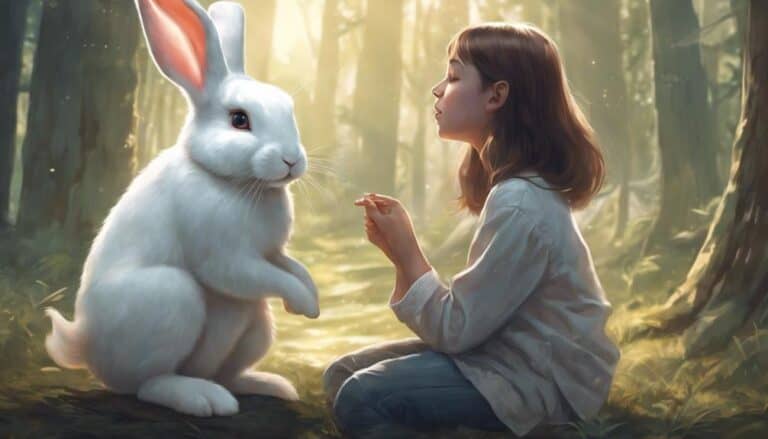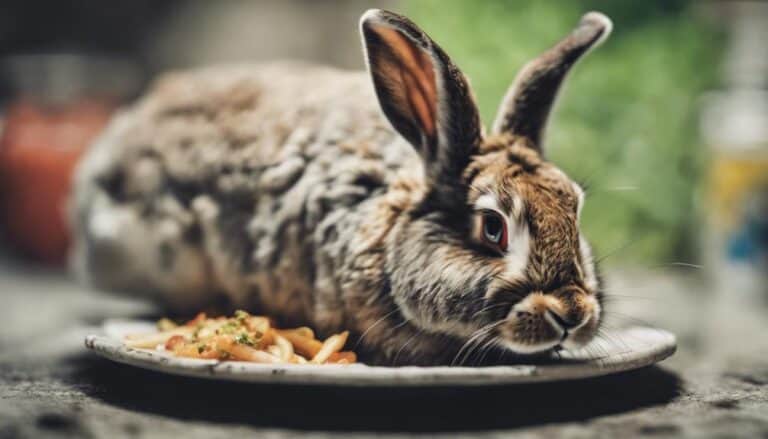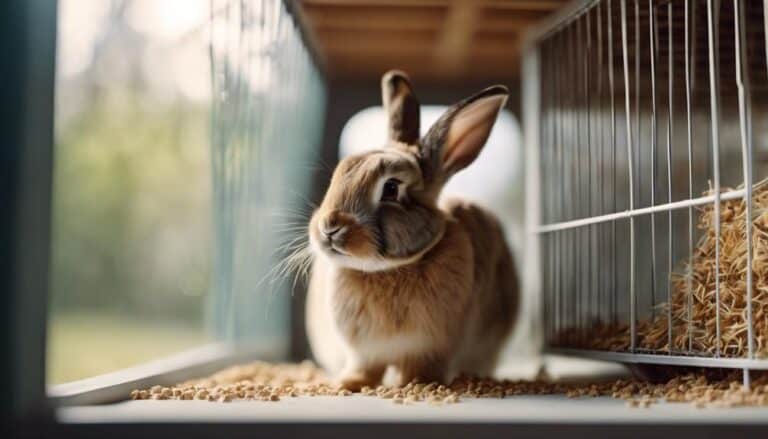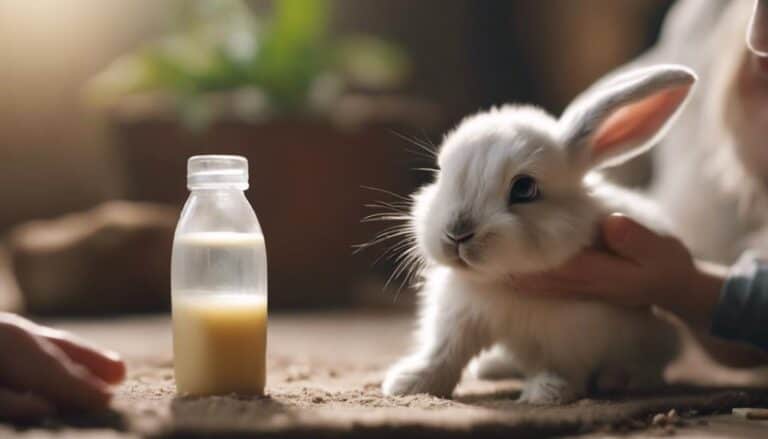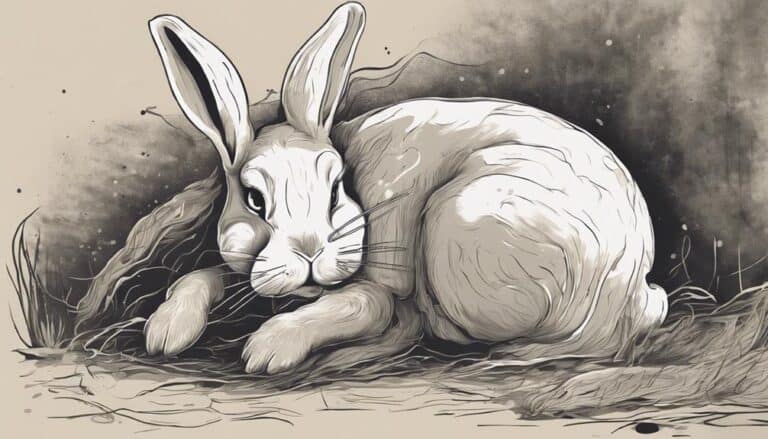When bunnies look at humans, they see a blurry image because of their monocular vision, which affects their depth perception. This way of seeing influences how they interact with you in their environment. Bunnies have a hard time judging distances accurately, so they are cautious when moving around obstacles.
Knowing their vision challenges can help you make their space safe and comfortable for them. Bunnies also rely on your movements, sounds, and scents to recognize you. Being gentle and respectful can build trust with these adorable creatures. Dive deeper into bunny perspectives and behaviors for a better understanding.
Contents
- 1 Key Takeaways
- 2 Bunny Vision: A 360-Degree Perspective
- 3 Depth Perception Challenges in Bunnies
- 4 Blind Spots in Bunny Vision
- 5 Color Perception in Rabbits
- 6 Low-Light Vision Abilities
- 7 Human Interactions From a Bunny's View
- 8 Rods Vs. Cones: a Visual Comparison
- 9 Understanding Bunny Vision: Insights
- 10 Enhancing Bunny-Human Relationships
- 11 Frequently Asked Questions
- 12 Conclusion
Key Takeaways
Bunnies use their vision, hearing, and sense of smell to understand how humans interact with them. When we move, talk, or leave our scent, bunnies can recognize and tell us apart. They might see our hands as either a threat or a source of food, so it's important to be gentle and respectful. By being kind and considerate, we can earn their trust and make them feel safe with us. To have positive interactions with bunnies, we need to understand and adjust to how they see colors and perceive the world around them.
Bunny Vision: A 360-Degree Perspective
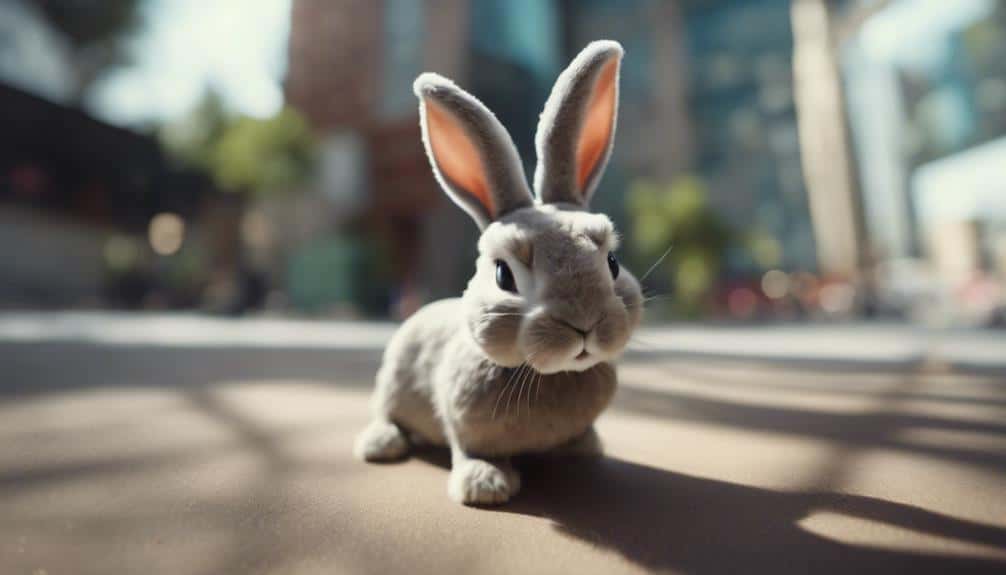
Bunnies have really good eyesight because their eyes are big and placed on the sides of their heads, giving them a wide view all around. This helps them stay alert and watch out for any danger nearby. They can look in different directions at the same time, which is super helpful for their survival in the wild. Bunnies can quickly switch between looking at one thing with one eye and using both eyes together, which helps them adapt to different situations easily.
Since bunnies are nearsighted, they're great at spotting things far away. This helps them see predators or find food from a distance. But when it comes to seeing things up close, like details or focusing on something nearby, they might struggle a bit. Knowing how bunnies see the world around them can help us understand how they experience things, especially appreciating their unique way of looking at things.
Depth Perception Challenges in Bunnies
Bunnies have a tough time with depth perception because their eyes are on the sides of their heads. This makes it hard for them to judge distances accurately. So, when they're trying to move around obstacles, they tend to be cautious and rely more on their other senses.
This can also affect how they behave around humans. Because of their depth perception challenges, bunnies mightn't feel as comfortable or trusting when interacting with people. It's important to be patient and understanding with them to help them feel safe and secure.
Bunny's Visual Range
Do you ever wonder how bunnies deal with depth perception challenges and how it affects their interactions with the world and other creatures?
Well, bunnies have monocular vision, which means they struggle with depth perception compared to us humans who've binocular vision. This affects how they see things around them.
Even though bunnies have a wide field of vision to spot predators from different directions, they might see humans as blurry due to their depth perception issues. To cope with this, bunnies rely a lot on spotting movement and changes in their surroundings to navigate their interactions with humans.
Knowing about these vision differences can help you adapt your interactions with bunnies, making sure you communicate effectively and respectfully in their unique visual world.
When bunnies move around, they face a special challenge because of their wide-angle vision and a small blind spot in front of their faces. This limited depth perception is due to how they see the world. Bunnies evolved as prey animals, so they've a wide field of view to spot predators from different directions. This focus on a broad view rather than depth perception affects how they deal with obstacles in their path.
Because of their vision, bunnies may have trouble judging distances accurately, especially when things are close by. This means it's important for us humans to make sure there are no obstacles in their way in places where they live. By knowing about these vision challenges, we can help our bunnies move around safely and comfortably, reducing the chances of accidents.
Impact on Behavior
When bunnies look at the world, they see things a little differently due to their wide-angle vision. Their depth perception isn't the best, which can affect how they interact with humans. Because they've a small blind spot in front of their faces, bunnies might approach cautiously to avoid bumping into things.
This cautious behavior is important for bunnies because it helps them stay safe. Since they can't see everything clearly, they rely on their sense of smell and hearing to navigate around humans. So, if a bunny seems a bit hesitant around you, it's just their way of being careful.
To make sure bunnies feel comfortable around you, it's essential to understand and respect their depth perception challenges. By being aware of their unique way of seeing the world, you can create a safe and welcoming environment for them. This will help build trust and positive relationships with these adorable little creatures.
Blind Spots in Bunny Vision
Bunnies have blind spots right behind them and in front of their noses because their eyes are on the sides of their heads.
It's important to know about these blind spots so you can approach bunnies in a way that makes them feel safe and not scared by sudden movements.
When you understand and respect their blind spots, you can build trust with these sensitive animals.
Bunny Peripheral Vision
Bunnies have amazing peripheral vision that allows them to see almost all around them, making it easier to spot any potential dangers or predators nearby. But they do have blind spots, like right behind them and directly in front of their noses. In these areas, bunnies may not notice movement or objects, which can affect how they react in different situations.
Despite these blind spots, bunnies make up for it by being really alert and using their wide field of vision effectively to stay out of harm's way. By being aware of where their blind spots are, you can approach and interact with bunnies more carefully and build a good relationship with these sensitive animals.
Bunny Depth Perception
Bunnies have really good peripheral vision, which helps them stay aware of what's going on around them. This also gives us clues about how they see the world and why they act the way they do.
One interesting thing to note is that bunnies have a small blind spot right in front of their noses. This can make it tricky for them to judge distances accurately, especially when someone or something is coming straight at them.
Because of this blind spot, bunnies may get a bit nervous when approached head-on. It's like trying to figure out how far away something is without being able to see it clearly. But bunnies have a cool trick up their sleeves – they can see on both sides independently with their monocular vision. This helps them keep an eye out for predators and other potential threats in their environment.
Having good peripheral vision and unique vision capabilities, bunnies are really good at spotting danger. Their ability to see a wide field of vision helps them survive in the wild. Plus, their depth perception plays a big role in how they interact with humans and their surroundings. By understanding these things, we can learn more about how bunnies behave and build a stronger bond with them.
Bunny Color Perception
When it comes to how bunnies see colors, it's clear that they've some limitations. Bunnies can't see red and yellow very well because they only have two types of cones in their eyes. This affects how they see things and how they react to their surroundings.
Bunnies have what's called dichromatic vision, which means they can see blue and green colors but have trouble with red and yellow. This is because of the limited number of cones in their retinas.
Interestingly, bunnies can see better in the dark than humans. This is because they've more rod cells in their eyes, which help them see in low light conditions.
One quirk of bunny vision is that they've a small blind spot right in front of their noses. This can affect their ability to see things up close.
Understanding how bunnies see colors and their unique visual system can give us insight into how they perceive the world around them and why they behave the way they do.
Color Perception in Rabbits
Rabbits see the world in blue and green shades because they've fewer color-detecting cones than humans. This means they can't distinguish between red and yellow. Their unique color perception is crucial for how they interact with their surroundings and people.
In their blue and green world, rabbits rely on these colors to find food, spot predators, and locate safe places to hide. Their color vision affects how they respond to different things, including humans. So, when you're around rabbits, keep their color vision in mind. Wearing colors in their blue and green spectrum can help them feel more comfortable and secure.
Understanding how rabbits see colors is important for creating environments that are visually suitable for them. By adapting to their unique color perception, you can improve their surroundings and encourage positive interactions with these amazing creatures.
Low-Light Vision Abilities
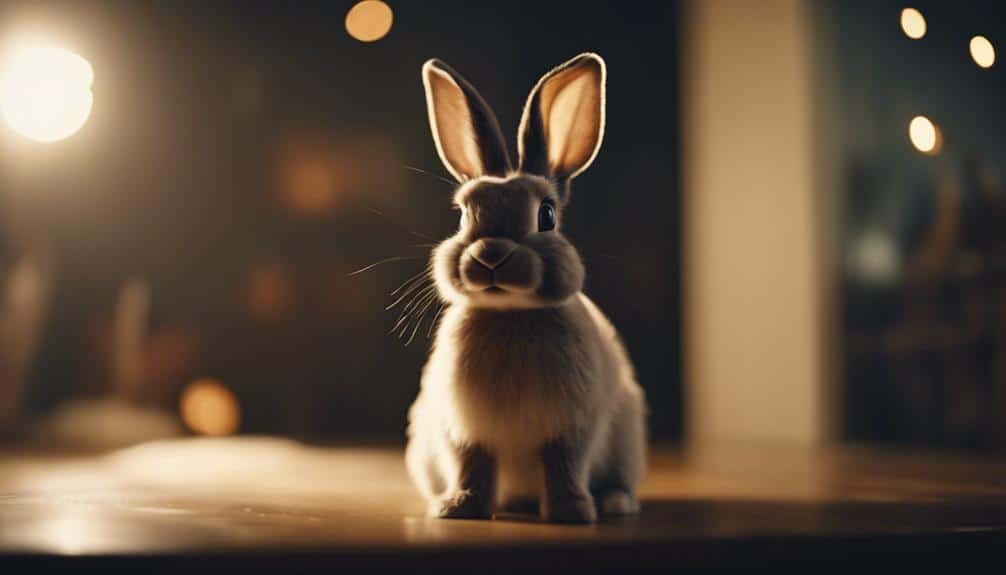
Rabbits can see much better in the dark than humans because they've a lot of rod cells in their eyes. This means they can navigate low-light conditions really well. So, how do bunnies make the most of their amazing night vision?
Well, in dim light, bunnies can see things more clearly compared to when it's pitch black. This helps them get around and find food even when it's not very bright out there. It's like they've their own built-in night vision goggles!
In the wild, rabbits rely heavily on their night vision to stay safe from predators and to hunt for food. Their ability to see well in the dark gives them a big advantage when it comes to survival. It's like having a superpower that helps them stay one step ahead of danger.
Because of how their rod and cone cells are spread out in their eyes, rabbits see things a bit grainy when it's completely dark. It's not like watching a clear HD movie for them, but it's still way better than what we can see in those conditions. Imagine looking through a slightly fuzzy lens – that's how it's for bunnies in the dark.
It's important to remember all this when creating environments for bunnies. They need spaces that take into account their low-light vision abilities to make sure they feel comfortable and can see things clearly. After all, we want our furry friends to be happy and healthy, right?
Human Interactions From a Bunny's View
Bunnies rely on their senses like vision, hearing, and smell to figure out what's going on around them, especially when humans are involved. They can see and hear us, but their eyesight isn't as detailed as ours. Because of this, they might find our size a bit daunting. When bunnies are around people, they pay close attention to how we move, talk, and smell to figure out who we are.
Depending on how a bunny has been treated in the past and the situation they're in, they might see human hands as either a threat or a source of food. It's important for us to be gentle and respectful when interacting with bunnies to build trust and make them feel safe. By understanding how bunnies see the world, we can create positive experiences for them and strengthen our bond with these adorable animals.
Rods Vs. Cones: a Visual Comparison
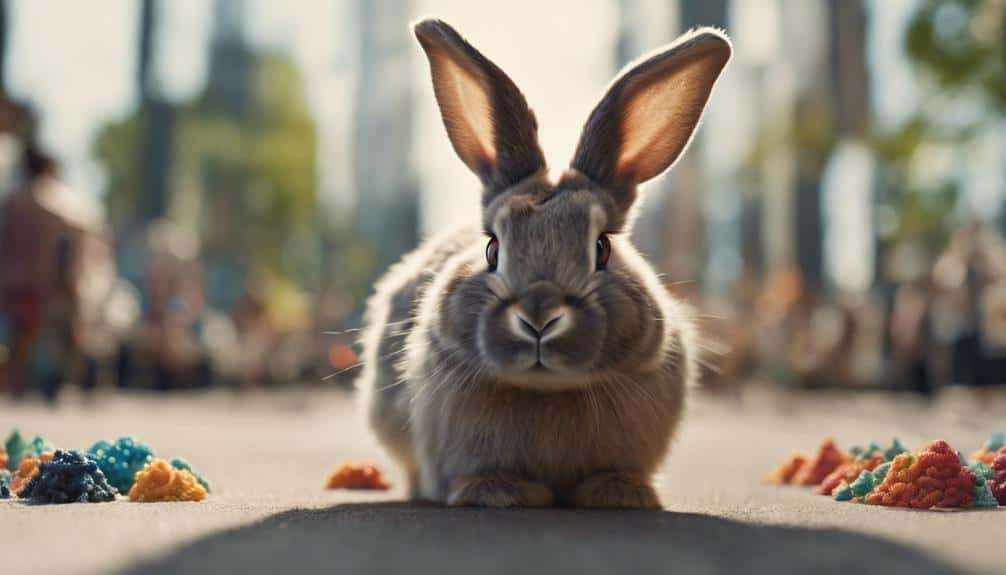
When we think about how bunnies see humans, it's crucial to know about the rod and cone cells in their retinas.
So, let's break it down: Rod cells help bunnies see well in low light, like when it's dark. Whereas cone cells are all about color and seeing things clearly. Interestingly, bunnies have more rod cells than cone cells in their eyes.
Because of this, bunnies heavily rely on rod cells for their vision, especially in dim light. Rod cells help them spot movement and shapes easily at night or in shady spots. Although cone cells play a role in color vision and details, the abundance of rod cells suggests that bunnies care more about detecting motion than seeing colors when they look at humans.
This balance between rod and cone cells gives us insight into how bunnies see the world. It shows us that they focus on movement and shapes when they interact with humans, highlighting the importance of these aspects in their perception.
Understanding Bunny Vision: Insights
Ever wondered what the world looks like through a rabbit's eyes? Bunny Vision gives us a peek into the sensory universe of these fluffy creatures, showing us how they see and react to the world around them.
Rabbits have a pretty wide field of vision, allowing them to spot humans from different angles quite easily. Unlike us, they don't focus much on faces to recognize people. Instead, they pay more attention to how we sound, move, and smell to figure out who's who.
Their eyes work independently, giving them a better chance to notice any potential threats, like predators (including us, sometimes). This makes them cautious around people, always on the lookout for any signs of danger.
Rabbit vision is all about staying safe and spotting trouble early. By understanding how they see things, we can improve our bond with these adorable companions. This not only helps us take better care of them but also strengthens the connection between humans and bunnies, making sure they're happy and healthy.
Enhancing Bunny-Human Relationships
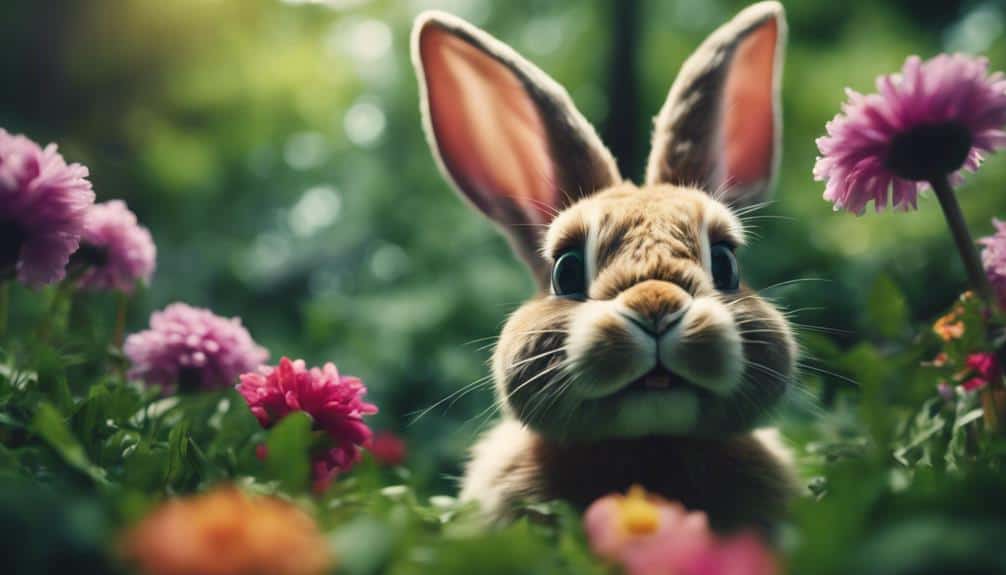
When you take a closer look at how bunnies perceive the world, you can find ways to strengthen the bond between rabbits and humans. Bunnies recognize humans through their voice, movements, and scents, forming a unique connection that can be deepened by understanding their perspective.
Knowing that bunnies can see humans clearly but with less detail due to their visual system, you can adjust your interactions to meet their visual needs and enhance your relationship. Here are some expert tips to help you improve your bond with your bunny:
- Be consistent in your cues: Bunnies respond well to familiar voices and movements, so keeping your interactions consistent can help strengthen your bond.
- Use visual aids: Adding objects with distinct shapes and colors in their environment can make things clearer for bunnies and make them feel more at ease.
- Pay attention to your body language: Being mindful of how your movements are perceived by bunnies can prevent misunderstandings and help build trust.
- Create a sensory-friendly environment: Understanding how bunnies experience scents and sounds can guide you in creating a space that enhances their well-being and happiness.
Frequently Asked Questions
How Do Rabbits See Humans?
Rabbits communicate by recognizing you through your voice, movements, and scent. They can see you clearly, although not as detailed as humans. Their wide-angle vision helps them spot potential threats, which is a survival skill they developed in the wild.
How Do Rabbits Feel About Humans?
You're really good at bonding with bunnies, like a carrot-wielding hero. When you come near, their little hearts beat with happiness. You easily earn their trust with your caring ways.
What Does My Rabbit Think of Me?
Your rabbit sees you as the one who makes them feel safe and cozy. By grooming you and seeking your company, they express their love and reliance on you. When you grasp their point of view, it helps to deepen your connection with them and makes your relationship even more special.
Do Rabbits Recognize Humans?
Rabbits know who you are by hearing your voice, seeing how you move, and picking up your scent. With their eyes on the sides of their heads, they can spot you from almost any direction. Knowing this helps us understand how rabbits see us.
Conclusion
Imagine if you were a bunny looking up at a towering giant with blurry features. You might see humans as these big, mysterious beings with limited depth perception and blind spots. It can be tough for bunnies to figure out what's going on in the world around them when they're dealing with these giant creatures.
Picture a bunny cautiously approaching a human hand that's offering a treat. The bunny mightn't be sure if the hand is a friendly gesture or a potential threat. It's like the bunny is trying to read the human's intentions and decide if it's safe to trust them.
When we understand how bunnies see us humans, we can adjust our behavior to help them feel more comfortable and build trust. It's all about building a good relationship with these adorable creatures and showing them that we're not so scary after all.

